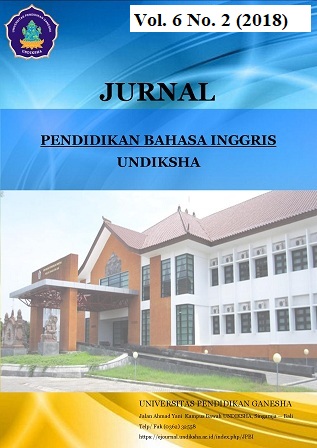THE QUALITATIVE EVIDENCES THAT DIFFERENTIATE PELAGA AND TAMBAKAN DIALECTS: A CONTRASTIVE STUDY
DOI:
https://doi.org/10.23887/jpbi.v6i2.20584Abstract
Abstract
The study aimed at contrasting the phonological systems of Pelaga Dialect (PD) and Tambakan Dialect (TD) and its implication to learning English as a foreign language. The subjects of this study were Pelaga and Tambakan dialects. This study was a contrastive research. The phonological systems of both dialects were firstly described. The obtained data in the form of wordlists (Swadesh, Budasi, and Holle) were collected through recording and listening and noting techniques. The result of the study shows that PD and TD have differences. In terms of phonemes, it was found that PD had 55 phonemes and TD had 48 phonemes. In term of vowel, the distribution of the vowels is different, although they have the same number of it. PD has 9 diphthongs and TD also has 9 diphthongs. From the 19 consonants of both dialects, most of the consonant have complete distribution. There is only the distribution of consonant /ʔ/ that differentiates both dialects in which in PD consonant /ʔ/ appears in the middle and final position, while in TD it appears in the final position only. In term of consonant cluster, PD has 17 consonant clusters and TD only has 11 consonant clusters. On the implication to learning English as a foreign language, English phonemes /ӕ/, /ɒ/, /ɜ/, /ɑ/, /ɑI/, /ɑʊ/, /f/, /v/, /ɵ/, /ð/, /z/, /ʃ/, /ʤ/ and all of the English triphthong are difficult to be pronounced by people in Pelaga and Tambakan.
Keywords : qualitative evidences, Pelaga dialect, Tambakan dialect, contrastive study
References
Al-Jarf, Reima. (2009). Contrastive Phonology. Riyadh
Anom, I Gusti Ketut. (1993). Tata Bahasa Bali. Bali: Upada Sastra
Bawa, I Wayan. (1983). Basa Bali Di Daerah Propinsi Bali: Sebuah Analisis Geografi Dialek. Unpublished thesis: Universitas Indonesia
Bhela, Baljit. (2009), Native Language Interference in Learning a Second Language: Exploratory Case Studies of Native Language Interference with Target Language Usage. (International Education Journal). Flinders University School of Education
Bonvilain, Nancy. (2003). Language, Culture, and Communication: The meaning of messages, fourth edition. New Jersey, Prentice Hall
Budasi, I Gede. (2007). Kekerabatan Bahasa-Bahasa di Sumba (Suatu Kajian Linguistik Historis Komparatif) (Disertasi). Yogyakarta: Fakultas Pascasarjana Universitas Gajah Mada
Cook, Carmen. (2010). Some Pedagogical and Practical Implications of Contrastive Studies in ELT. (Article). Universidad de Alcala de Henares
Gast, Volker. (2013). Contrastive Analysis. Cambridge: The University Printing House
Gautama, B. Wayan. (2005). Tata Sukerta Basa Bali. Denpasar: CV. Kayumas Agung
Gimson, A.C. (1970). An Introduction to the Pronunciation of English. England: J.W. Arrowsmith Ltd
Hornby, AS. (2000). Oxford Advanced Learner’s Dictionary. Sixth Edition Oxford. Oxford University Press
Jones, Daniel. (1972). The Pronunciation of English. Cambridge: The University Printing House
Kampusu, E. Yunus. (2009). Comparing and Contrasting First and Second Language Acquisition: Implications for Language Teachers. (Journal). Anadolu University
Keraf, G. (1996). Linguistik Bandingan Historis. Jakarta: Pustaka Indonesia
Kridalaksana, Harimurti. (2001). Kamus Linguistik: Edisi Ketiga. Jakarta: PT. Gramedia Pustaka Utama
Mettaningrum, Gustiana. (2011). The Qualitative Phonological and Lexical Evidences that Unite Bondalem and Julah Dialects: A Comparative Study. Unpublished handout: Undiksha Singaraja
Nordquist. R. (2013). Language. Grammar and Composition. Retrieved from http://grammar.about.com/od/il/g/languageterm.htm/ on January, 2 2014
Pastika, Wayan. (2005). Fonologi Bahasa Bali: Sebuah Pendekatan Generatif Transformasi. Bali: Pustakan Larasan
Pike, Kenneth L. (1947). Phonemics: a technique for reducing language to writing. Ann Arbor: the unity of Michigan Press
Roach, Peter. (1983). English Phonetics and Phonology: A Practical Course. Cambridge: Cambridge University Press
Roediyanto, Razak. (1983). A course in phonology. FKIP Udayana University Singaraja: Unpublished
Seken, I Ketut. (1992). Introduction to Linguistics. Fakultas Keguruan dan Ilmu Pendidikan Universitas Udayana. Diktata (Unpublished)
Soebroto, Edi. (1992). Linguistics Structural. Surakarta: University press
Sulaga, I Nyoman. (1996). Tata Bahasa Baku Bahasa Bali. Denpasar: Pemerintah Provinsi Daerah Tingkat I Bali
___________, _: Allophone. http://en.wikipedia.org/wiki/Allophone. Accessed on January 3, 2014
Downloads
Published
Issue
Section
License
Authors who publish with the Jurnal Pendidikan Bahasa Inggris Undiksha agree to the following terms:- Authors retain copyright and grant the journal the right of first publication with the work simultaneously licensed under a Creative Commons Attribution License (CC BY-SA 4.0) that allows others to share the work with an acknowledgment of the work's authorship and initial publication in this journal
- Authors are able to enter into separate, additional contractual arrangements for the non-exclusive distribution of the journal's published version of the work (e.g., post it to an institutional repository or publish it in a book), with an acknowledgment of its initial publication in this journal.
- Authors are permitted and encouraged to post their work online (e.g., in institutional repositories or on their website) prior to and during the submission process, as it can lead to productive exchanges, as well as earlier and greater citation of published work. (See The Effect of Open Access)













